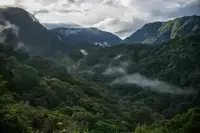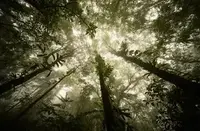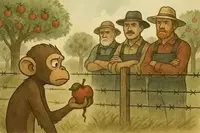The Curious Case of the Shorter Trees along the Amazon near Iquitos, Peru

The Curious Case of the Shorter Trees and broken canopies along the Amazon near Iquitos, Peru | March 3, 2025
Introduction
When you imagine the Amazon rainforest, you might picture towering trees with a lush, closed canopy. Yet if you travel downstream from Iquitos, Peru, you’ll notice something different: the trees lining the Amazon River are often smaller, and the canopy is more open and patchy. What’s going on in this stretch of jungle? It turns out a mix of natural forces and human history have shaped these floodplain (“várzea”) forests in unique ways. Let’s explore the key factors:
Seasonal Floods: Life in a Waterlogged World
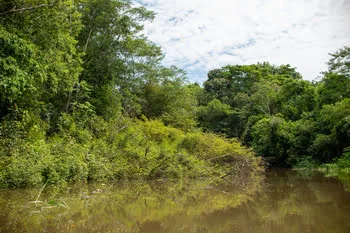
Every year, the Amazon River swells with rainwater and overflows its banks, inundating vast areas of forest. In the Iquitos várzea (floodplain), the river can rise up to 7 meters (23 feet) during the rainy season[1]. For months at a time (often up to 6–10 months of the year), tree trunks stand in water. This seasonal flooding creates a harsh environment for trees. Waterlogging of the soil means roots don’t get much oxygen, and many less-tolerant trees can literally suffocate or rot. The rushing floodwaters can also uproot or break trees, especially smaller ones, opening gaps in the forest. In fact, studies indicate that flooding is a greater stress on these forests than occasional treefalls; a flood can knock down many trees at once, removing more biomass than a single tree falling.
To survive these conditions, várzea tree species have special adaptations. Many have buttressed or stilt roots for stability in soft, flooded soils, or can tolerate having “wet feet” for extended periods. Still, the flood stress stunts their growth compared to trees on higher ground. Research comparing seasonally flooded forests to unflooded uplands (terra firme) found that trees in floodplains tend to be shorter and more branched, whereas upland trees grow taller and straighter. In floodplains, trees often put energy into quick spurts of growth when conditions are favorable and develop lighter wood, rather than slowly building the towering, dense trunks seen in non-flooded forests. In extreme cases like blackwater floodplain (igapó) forests, which endure long floods and poor nutrients, trees remain very small with thin, flexible trunks. The Iquitos area is flooded by nutrient-rich “whitewater,” so its trees aren’t as stunted as in igapó, but the annual flood pulse still limits how big and closed the canopy can get. Many floodplain trees even shed leaves during the peak floods (a strategy to reduce stress), leaving patches of canopy seasonally sparse.
On the upside, the floods also bring fresh sediments from the Andes, turning the forest floor into a fertile mudflat when waters recede[1][2]. Within weeks of the dry season onset, the landscape springs back: grasses and seedlings carpet the ground, and flood-tolerant trees flush out new leaves. This boom-and-bust rhythm means the forest growing here is adapted to be fast and dynamic, rather than slow and massive. The regular deposition of silt gives plants plenty of nutrients, but the physical battering and waterlogging keep the overall structure lower and more open.
Fertile Mud, Shallow Roots: Soil Nutrients in the Floodplain
One might think that perhaps the soil itself is poor, keeping trees small. In upland Amazon forests, the soils are often ancient and nutrient-poor, but that’s not the case in these floodplains. The rivers around Iquitos are “whitewater” streams born in the Andes mountains. They carry loads of mineral-rich sediments (full of phosphorus, calcium, and other nutrients) and spread them across the várzea each year[2]. As a result, floodplain soils are actually quite fertile, often far more so than the red clays of the terra firme uplands[3][4]. One ecological survey notes that the rich sediments make the várzea “very fertile compared to the terra firme land further from the river”[3]. So nutrient scarcity is not the limiting factor here – these forests can grow rapidly thanks to an annual infusion of fresh soil.
However, there is a catch: because new sediment is laid down regularly, the soil profile is shallow and constantly changing. Trees in the floodplain can’t put down extremely deep roots over centuries, because the ground they stand on is geologically young and frequently disturbed. Moreover, the fine silts can become waterlogged or form a heavy clay layer when wet, which might inhibit deep root penetration. In essence, the trees have plenty of food (nutrients), but a wobbly dining table. They prioritize quick growth and reproduction in a capricious habitat, rather than investing in super-deep roots or massive woody trunks that take decades to pay off. So while soil fertility is high, it doesn’t translate into giant trees the way you might expect, due to the other physical stresses at play.
A River that Rewrites the Forest

Another reason the canopy stays open and trees smaller is that the Amazon River is constantly on the move. Downstream of Iquitos, the Amazon’s course wiggles and shifts relentlessly across the flat basin. It erodes its banks on one side and deposits sandbars on the other, meandering in broad loops and occasionally cutting new channels. As the river channel migrates, it continuously reshapes the floodplain. Forest that was growing along the bank may suddenly find itself sliced away by erosion during a high flood. Elsewhere, new land emerges as a sandbar or island, ready to be colonized by plants.
In the Iquitos várzea, this dynamic is very evident. The landscape is a patchwork of oxbow lakes (former river bends cut off from the main flow), levees, marshes, and young riverine forests[1]. Large portions of the forest are essentially in recovery mode from recent disturbances. One description notes that the meandering rivers create “a complex landscape of oxbow lakes, marshes, levees and bars, with grasslands, shrubs and forests in different stages of succession”[1]. In short, you don’t just have one uniform old-growth forest – you have many mini-forests of different ages. Where the river flooded or changed course 20 years ago, you might see only low shrubs and fast-growing pioneer trees. Nearby, on slightly older and higher ground spared from floods for a few decades, you’ll find taller “mature” trees like ceiba and Brazil nut. But eventually, even those older stands may be reset by the river’s whims.

Because of this continuous disturbance, the forest along the Amazon here rarely reaches the kind of stately maturity seen in more stable landscapes. Scientists studying Amazonian floodplains emphasize that cycles of erosion and sedimentation cause “habitat types of different successional stages [to] occur simultaneously within limited areas of the várzea”[5]. It’s a mosaic of young, recovering forest patches rather than a single, climax rainforest. Imagine a neighborhood where some houses are brand new, others are mid-renovation, and a few older ones sit at the edge – that’s the floodplain forest, constantly rebuilding itself. This naturally keeps the average tree size smaller and the canopy broken up by open areas of grass or young regrowth.
The Never-Ending Succession: Youthful Forests by Nature

Given the frequent flooding and river migration, it’s no surprise that várzea forests are often young in age structure. Ecologists sometimes call these “succession forests” because they are perpetually in stages of succession (the ecological term for how ecosystems regenerate after disturbance). Early-succession species like Cecropia trees (imagine the quick-growing, umbrella-like “emergency responders” of the forest) are common after floods[1]. These fast growers shoot up in open sunlight but typically top out at moderate heights. Over time, if a patch of forest remains undisturbed for many years, later-succession species move in – hardwoods and palms that grow more slowly and taller. Indeed, on older alluvial terraces that haven’t been scoured recently, one can find large trees such as kapok (Ceiba), wild fig, and virola reaching into the canopy[1]. But such pockets of old floodplain forest are interspersed with much younger tracts.
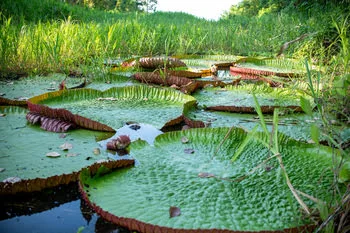
The net effect is that the canopy height averaged over the landscape is relatively low, and gaps are common. A field study in a Peruvian floodplain found abundant small stems and very high turnover rates – trees come and go quickly[5]. This constant churn favors a dense understory of vines, shrubs, and young trees rather than a few enormous trunks. In contrast, an undisturbed terra firme (upland) rainforest might have the same giant trees standing for centuries, sealing the canopy and shading out the undergrowth. The várzea is more of a boomtown forest – always rebuilding, never getting very old. Many stands could be considered “secondary forest” not because of human logging, but because nature itself is constantly resetting the clock with floods and erosion.
Quiet Harvest: The Subtle Hand of Logging
Natural forces aren’t the only reason for the smaller trees – humans have played a role too. The Amazon River has long been a highway for people, and the Iquitos region’s floodplain forests have been more accessible to humans than remote uplands. Over the years, there has been selective harvesting of large, valuable trees along the river. Even though large-scale commercial logging is limited in protected areas, local communities and past enterprises have removed many towering hardwoods. Timber extraction in the Iquitos várzea (for cedar, mahogany, kapok, and other prized woods) has been documented as a significant cause of deforestation[1]. Because one can float logs out via the river, even relatively isolated stands were logged in the past.
What does selective logging do to the forest structure? Essentially, it plucks out the biggest trees, leaving behind gaps that are filled by younger regrowth. If this happens repeatedly over decades, the result is a forest missing its oldest giants. Many stretches downstream of Iquitos have indeed “suffered from extensive deforestation to extract timber and create pasture for livestock”[1]. Even when outright clearing is not done, the quiet removal of a few big trees per kilometer over many years adds up. The canopy opens where a giant was removed, and the replacement trees are smaller. A scientific review notes that várzea forests have been attractive for logging because, although they’re slightly less diverse than terra firme forests, they still contain great amounts of usable timber and are easier to reach[5]. This legacy of piecemeal logging has likely skewed the forest toward smaller average tree size, compounding the natural effects of flooding.
It’s worth noting that nowadays much of this region is designated as reserves (like the Pacaya-Samiria National Reserve) or managed by local communities, so large trees are somewhat protected. But the historical impact is already imprinted on the landscape – truly ancient trees are scarce near the river’s edge because many were felled in the past. In their place stands secondary growth or young primary forest that hasn’t yet had time (or stable conditions) to produce 50-meter giants.
People of the Floodplain: Thousands of Years of Influence
Humans have lived along the Amazon’s banks for millennia – long before Iquitos existed. Indigenous communities adapted to the floodplain environment, practicing fishing, small-scale farming, and forest management. Their presence has subtly shaped the forest composition over time. For example, certain useful trees and palms are more common near long-term habitation sites due to planting or encouragement. The buriti palm (Mauritia flexuosa), which provides fruit and thatch material, often forms extensive stands in the region[2]. This palm thrives in flooded areas and is sometimes even semi-cultivated. Likewise, indigenous peoples may have promoted fruiting trees like Inga, Spondias (mombín), or Pseudobombax that attract game or provide food. Such practices result in a forest that has a higher proportion of mid-sized fruit trees and palms – again tilting the structure away from just a few enormous hardwoods.
Moreover, shifting agriculture has long been practiced on the high levees and natural river terraces. Communities would clear small patches of forest to plant crops like manioc or maize, then after a few years, let them fallow and regenerate. These fallow areas regrow as secondary forest, typically dominated by fast-growing, small-tree species. Today, much of the Amazon várzea continues to be used in this rotational way. In fact, a recent overview of the Iquitos várzea ecoregion notes that “much of the forest is managed or unmanaged secondary forest” under smallholder use[2]. In other words, the hand of humans has kept parts of the forest in a youthful stage, intermingled with more natural regrowth. Over thousands of years, even low-density indigenous populations can have a cumulative effect: certain large trees might have been selectively girdled or cut for canoe timber, occasional fires from cooking or field-clearing may have escaped and thinned the forest, and favored species were encouraged.
That said, it’s important to stress that indigenous influence was generally patchy and sustainable compared to modern deforestation. They created a kind of semi-domesticated landscape with rich biodiversity. The forest along the Amazon is by no means a plantation – it’s mostly wild – but calling it pristine would ignore this long human history. The slightly more open canopy and prevalence of useful plant species hint at a co-created ecosystem. In combination with natural flood dynamics and past logging, the long-term habitation by people has contributed to a forest that “looks” different from a totally untouched rainforest.
Not Your Typical Jungle: A Different Look than Costa Rica’s Forests
All these factors – flooding, fertile but unstable soils, river disturbances, high turnover, selective logging, and human management – explain why the Amazon downstream of Iquitos has a more open, younger-looking forest compared to, say, the primary rainforests of Costa Rica or other regions. In a Costa Rican old-growth rainforest (for example, in the lowlands of the Osa Peninsula or near Tortuguero), you would see a continuous canopy 40–60 meters high with emergent trees even taller, and very little light reaching the ground[6]. Those forests don’t experience massive annual floods, and some haven’t been heavily disturbed for centuries, allowing trees to grow extremely tall and straight. The result is a cathedral-like environment – towering buttresses, deep shade, and a relatively uniform, closed canopy. The terra firme rainforests in parts of the Amazon (upland areas away from whitewater rivers) are similar – their canopy can reach 30–37 m with emergent giants 45–50 m tall[7][8], and they contain an incredible diversity of tree species all competing for sunlight in a stable setting.
By contrast, the Iquitos floodplain forest tops out around 20–30 m on average, with only occasional emergent trees if any. One survey of a Central Amazon várzea noted that forests on the natural levees (the highest ground in the floodplain) reach about 25 m tall[3]. Behind those levees, the habitat shifts to more open wetlands or savanna-like grasslands in places, further lowering the overall “treeiness” of the view[3]. Even where the forest is dense, it often has gaps from flood damage or younger patches recovering from the last disturbance. The variety of successional stages side by side means you might boat past a grove of mature trees one minute and a expanse of low bush and cane grass the next. In essence, this stretch of Amazon forest is more dynamic and patchy than the postcard image of an undisturbed tropical jungle.
It’s also worth noting that different parts of the Amazon can look very different. The Peru/Brazil Upper Amazon floodplains around Iquitos are one case. If you were to compare that to, say, a blackwater river region (like near the Rio Negro), you’d find even sparser tree cover in some flooded areas (with more swampy peat forests). Or if you went to the Andean foothills in Ecuador or Colombia, you’d find taller forests on nutrient-rich soils but on steep terrain. So “the Amazon” is not uniform. In the Iquitos region, we have the confluence of factors that favor a somewhat shorter, more open canopy.
Bringing It All Together
So, why are the trees smaller and the canopy more open along the Amazon downstream of Iquitos? It’s not just one reason – it’s a blend of environmental challenges and human touch. The yearly floods act like a natural tree pruning and fertilizing service all at once, forcing the forest to regrow frequently. The shifting river sands mean the ground under the forest is young and restless. The forest itself is largely in perpetual recovery (succession) from the latest flood or channel change. Add to that a history of humans using the forest – from indigenous agroforestry to selective logging and cattle pastures – and you end up with a landscape that is biologically rich and green, but with fewer giants and more sunlight on the forest floor.
This mosaic of smaller trees, open canopy, and wetlands is actually incredibly productive for wildlife. The floodplain forest feeds multitudes of fish with its falling fruits, and it provides habitat for specialized creatures like river dolphins, manatees, and wading birds that you won’t find in a drier rainforest[1][2]. In a way, the open canopy and seasonal openings are a feature, not a bug – they allow grasses and flood-tolerant plants to thrive, which in turn support herbivores and seed dispersers. The Amazon is a master of adaptation, and the várzea is one of its most dynamic and resilient ecosystems.
Next time you find yourself gazing at the scrappy-looking jungle along a mighty river, remember that an interplay of hydrology, soil, disturbance, and humanity has crafted that scenery. It may not look like a stereotypical “Tarzan” jungle, but it’s a living testament to the power of the Amazon’s flood pulse. Smaller trees and an open canopy tell a story of a forest that dances to the river’s rhythm – a dance of resilience in an ever-changing environment.
360 degree tour of the Oran River, a tributary of the Amazon in the Iquitos várzea
To adjust video quality, press play, click the gear icon (⚙️) in the video player, and select 'Quality'. Drag your mouse in the video to look around in 360 degrees.
Are you interested in visiting the Amazon river, Amazon rainforest, and the Iquitos várzea? Read all about the Otorongo ecolodge here. Or if this article has left you with more questions about the várzea, you may find the answer to your question in the FAQ section below.
FAQ
-
If várzea forests have nutrient-rich soil, why don’t they have more biodiversity than upland (terra firme) forests?
Despite being fertile, várzea forests experience extreme physical stress due to seasonal flooding, erosion, and sedimentation. These conditions limit the types of plants that can survive there. In contrast, terra firme forests have stable, albeit nutrient-poor, soils that allow for a much greater variety of tree species to establish and persist over time. Read more about rainforests soil fertility here.
-
Are there any areas near Iquitos where the forest does resemble the tall, closed-canopy Amazon rainforest found in other regions?
Yes. If you move away from the várzea floodplains into terra firme forests that are higher in elevation and never flood, you will find taller trees and a more continuous canopy. However, terra firme forests near Iquitos may still have been affected by selective logging or long-term human use, so they might not be as pristine as deep Amazonian forests.
-
How do animals adapt to the more open canopy of várzea forests?
Many várzea animals take advantage of the seasonal changes in the forest. Some birds and primates migrate between várzea and terra firme areas to find food. The gaps in the canopy allow more sunlight to reach the forest floor, encouraging fruiting plants that attract herbivores and pollinators. Aquatic species also play a crucial role, as fish feed on fallen fruits and disperse seeds.
-
Does várzea forest ever transition into another type of forest over time?
Yes, if a várzea area stops flooding (for example, due to river course changes), it can gradually develop into terra firme-like forest. Over time, the composition of trees will shift, with flood-tolerant species dying out and upland species colonizing the area. However, this process can take centuries, as the soils and hydrology continue to influence which plants dominate.
-
Could reforestation projects increase the number of large trees in the Iquitos floodplain?
Reforestation is possible but challenging in várzea forests because the land is so dynamic. While it’s feasible to plant fast-growing flood-tolerant species, establishing a stable population of large, long-lived trees would be difficult since floods frequently reset the ecosystem. A better approach may be promoting natural regeneration by protecting mature seed trees and limiting human disturbances.
-
Are there other major river systems in the world where floodplain forests have similar characteristics?
Yes! The Congo River floodplain in Africa and the Mekong River floodplain in Southeast Asia have várzea-like seasonal flooding, nutrient-rich soils, and fast-growing trees. These ecosystems share similar adaptations, such as trees with stilt roots and wildlife that depend on seasonal inundation cycles.
-
How do várzea forests compare to mangrove forests, which also grow in flooded conditions?
Both forests deal with waterlogged soils, but mangroves grow in saltwater or brackish environments, whereas várzea trees grow in freshwater. Mangroves have specialized adaptations like salt-excreting leaves and aerial roots, while várzea trees rely more on flood tolerance and rapid growth. Furthermore, mangrove trees only grow along the water and don't have inland counterparts to compare to. Whereas, the vegetation of the várzea can grow further away from the rivers and consequently get larger over time.
-
Are there várzea forests that are older and more stable than those near Iquitos?
Yes, some várzea regions in Brazil, particularly in low-disturbance floodplains of the central Amazon, have areas of mature várzea forest with larger trees. These areas experience fewer erosional changes and may be centuries old, allowing certain tree species to grow taller than those in more dynamic floodplains.
-
Do várzea forests produce commercially valuable timber?
Yes, but not as much as terra firme forests. Some várzea trees, like Virola (wild nutmeg) and Ceiba (kapok), have commercial value, but the constant flooding makes várzea trees less dense and slower to dry for timber use. Many of the high-value hardwoods, like mahogany and ipe, are found mainly in terra firme forests.
-
Could human activity ever cause várzea forests to disappear completely?
Deforestation, dam construction, and climate change pose threats to várzea forests. Hydroelectric dams, for example, can disrupt natural flooding cycles and prevent the seasonal sediment renewal that várzea trees depend on. If these ecosystems become too disturbed, they could transition into shrublands or degraded wetlands, losing their current structure and biodiversity.
References
- Iquitos Várzea – Wikipedia. (2023). Iquitos várzea. Retrieved from Wikipedia: https://en.wikipedia.org/wiki/Iquitos_v%C3%A1rzea
- One Earth. (2020). Iquitos Várzea. Retrieved from OneEarth.org: https://www.oneearth.org/ecoregions/iquitos-varzea/
- Wikipedia. (2021). Gurupá várzea. Retrieved from Wikipedia: https://en.wikipedia.org/wiki/Gurupa_v%C3%A1rzea
- Wikipedia. (2021). Purus várzea. Retrieved from Wikipedia: https://en.wikipedia.org/wiki/Purus_v%C3%A1rzea
- Wikipedia. (2021). Várzea forest. Retrieved from Wikipedia:https://en.wikipedia.org/wiki/V%C3%A1rzea_forest
- CostaRica21. (2011). Tropical Rainforest Biome – Costa Rica. Retrieved from costarica21.com: https://www.costarica21.com/Tropical-Rainforest.html
- Oliveira, A., & Mori, S. (1999). A central Amazonian terra firme forest. Boletim do Museu Paraense Emílio Goeldi, Série Botânica, 15(1), 1–15. Retrieved from
- Mesquita, R. C. G., Ickes, K., Ganade, G., & Williamson, G. B. (2001). Alternative successional pathways in the Amazon Basin. Journal of Ecology, 89(4), 528–537. https://doi.org/10.1046/j.1365-2745.2001.00583.x
